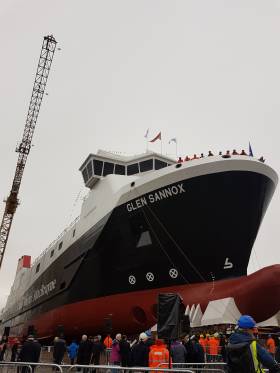Displaying items by tag: Isle of Arran, Clyde
Ferguson Marine to Lodge Claim in Arran, Scotland Ferry Design Row
#ferry- In a row between a Scottish shipyard and operator over claims that "significant design changes" to CalMac's delayed new Arran ferry today (Friday, 7 Dec.) has escalated to legal action, reports The Scotsman.
Port Glasgow shipbuilders Ferguson Marine Engineering Limited (Fmel) announced it planned to make a claim against Scottish Government-owned Caledonian Maritime Assets Limited (Cmal) - which owns CalMac's ferries - over the £97 million contract for the as previously Afloat.ie covered Glen Sannox and a sister vessel.
It said a claim would be lodged "within weeks" over the project to build the ferries which will be able to run on liquid natural gas or diesel.
Fmel has blamed the changes and the newness of the technology involved for delays to the Glen Sannox, which could now enter service on the main Arran route (see piece) a year late.
It may not now carry passengers until next autumn.
For further comments from both Fmel and Cmal, click here.
Redevelopment of CalMac Ferry Terminal on Isle of Arran
#Redevelopment - Caledonian MacBrayne (CalMac) the Scottish Government funded publically owned ferry network, which was awarded an EU tendering process to continue running Clyde and Western Isles services, is involved in redeveloping a ferryport, writes Jehan Ashmore.
On one of CalMac's Forth of Clyde routes, Ardrossan-Brodick, Isle of Arran, is where construction is underway at a ferryport. The redevelopment is the construction of a new double-berth and ferry terminal in Brodick which is progressing at the island’s main town on the east coast. On a related note the Irish port of Wicklow is connected in the terminal project, through a regular caller (click report here)
The ferry to Arran, is the most southerly of the Scottish Western Isles services, though a summer-only mainland connection also links Ardrossan, in Ayrshire and Campbeltown on the Mull of Kintyre, Argyle.
As part of the overall redevelopment at Brodick Ferry Terminal a Passenger Access System (PAS) is scheduled to be commissioned in summer 2017 before the new facility is completed and handed over to CalMac Ferries Ltd in August 2017.
In a further boost of confidence for the route and notably to serve the islanders and tourists alike, is the addition of new tonnage which is also to arrive from Spring 2018.
A pair of 100m long newbuild ferries, each with a 1,000 passenger capacity and 127 cars/16 HGV's (or combination) are on order for construction to Fergusan Marine Engineering Ltd (FMEL) on the Clyde.
The £97m contract is from Caledonian Maritime Assets Ltd (CMAL) which owns the 31 strong fleet, as well to properties at piers and harbours at more than 26 locations throughout Scotland.
The newbuilds are earmarked for the Ardrossan-Brodick and the Uig Triangle routes. A final decision, however on deployment rests with the ferry operator and will be informed by further analysis of demand on all major routes.
The more environmentally friendly newbuilds are to be ‘dual-fuel’ powered through use of liquefied natural gas (LNG) and marine diesel.





























































